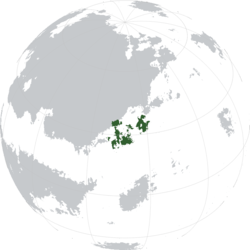Difference between revisions of "Milevian Confederacy"
Total pleb (talk | contribs) m |
Total pleb (talk | contribs) |
||
| Line 17: | Line 17: | ||
| event_end = [[Collapse of the Milevian Empire|Collapse]] | | event_end = [[Collapse of the Milevian Empire|Collapse]] | ||
| title_leader = Grand Steward | | title_leader = Grand Steward | ||
| leader1 = [[ | | leader1 = [[Jaddemarrash]] <small>(first)</small> | ||
| year_leader1 = X | | year_leader1 = X | ||
| image_flag = | | image_flag = | ||
| Line 47: | Line 47: | ||
The '''Milevian Empire''' was a somewhat loose confederation of Milevic chiefdoms in eastern Parshita. It existed from X until its collapse in the 17th Century. | The '''Milevian Empire''' was a somewhat loose confederation of Milevic chiefdoms in eastern Parshita. It existed from X until its collapse in the 17th Century. | ||
The empire was founded upon and organised around [[Milevic clan system|a unique system of clans and sodalities]] wherein ruling clans of chiefdoms would band together regardless of kin to form a guild that performed a certain function (for example, a fishing sodality). This was a voluntary association as opposed to a system of vassalage, and as such the individual chiefdoms enjoyed a great degree of autonomy prior to the later years of the empire. Within the empire this system allowed regions to become specialised in the provision of a particular good or service | The empire was founded upon and organised around [[Milevic clan system|a unique system of clans and sodalities]] wherein ruling clans of chiefdoms would band together regardless of kin to form a guild that performed a certain function (for example, a fishing sodality). This was a voluntary association as opposed to a system of vassalage, and as such the individual chiefdoms enjoyed a great degree of autonomy prior to the later years of the empire. Within the empire this system allowed regions to become specialised in the provision of a particular good or service. | ||
Terminian influence and attempts to centralise the empire led to its downfall in the 17th Century. In the years following its collapse the former empire was conquered and incorporated into the [[Terminian Far East]]. | Terminian influence and attempts to centralise the empire led to its downfall in the 17th Century. In the years following its collapse the former empire was conquered and incorporated into the [[Terminian Far East]]. | ||
| Line 70: | Line 70: | ||
===Government=== | ===Government=== | ||
Each chiefdom within the confederation was placed in a regional grouping overseen by a ''steward'' elected by the clans in a region, usually from their own ranks, who would oversee business and trade and resolve disputes between the clans under their jurisdiction. In the later stages of the empire these regions became de facto provinces, while the chiefdoms played a role more akin to districts within them. | |||
In addition to regional stewards, every ruling clan would occasionally elect a ''grand steward'', a de facto emperor. | |||
==Economy== | ==Economy== | ||
Revision as of 22:31, 9 June 2018
| Milevian Empire | |||||
| TBA | |||||
| |||||
| Capital | Phamphar (de facto) | ||||
| Languages | Imperial Milevian Old High Czisilian Others | ||||
| Government | Elective monarchy | ||||
| Grand Steward | |||||
| • | X | Jaddemarrash (first) | |||
| Legislature | Stewards' Council | ||||
| Historical era | Late Middle Ages | ||||
| • | Established | 1200s | |||
| • | Collapse | 1600s | |||
| Today part of | Others | ||||
The Milevian Empire was a somewhat loose confederation of Milevic chiefdoms in eastern Parshita. It existed from X until its collapse in the 17th Century.
The empire was founded upon and organised around a unique system of clans and sodalities wherein ruling clans of chiefdoms would band together regardless of kin to form a guild that performed a certain function (for example, a fishing sodality). This was a voluntary association as opposed to a system of vassalage, and as such the individual chiefdoms enjoyed a great degree of autonomy prior to the later years of the empire. Within the empire this system allowed regions to become specialised in the provision of a particular good or service.
Terminian influence and attempts to centralise the empire led to its downfall in the 17th Century. In the years following its collapse the former empire was conquered and incorporated into the Terminian Far East.
Etymology
History
Establishment
Arrival of Terminians
Collapse
Geography
Politics
Administrative Divisions
The empire was divided into a multitude of individual chiefdoms, each headed by a different ruling clan.
Government
Each chiefdom within the confederation was placed in a regional grouping overseen by a steward elected by the clans in a region, usually from their own ranks, who would oversee business and trade and resolve disputes between the clans under their jurisdiction. In the later stages of the empire these regions became de facto provinces, while the chiefdoms played a role more akin to districts within them.
In addition to regional stewards, every ruling clan would occasionally elect a grand steward, a de facto emperor.
